Intro to Short-Term Economic Fluctuations
1/30
There's no tags or description
Looks like no tags are added yet.
Name | Mastery | Learn | Test | Matching | Spaced |
|---|
No study sessions yet.
31 Terms
Recession/Contraction
A period in which the economy is growing at a rate significantly below normal
A period during which real GDP falls for two or more consecutive quarters
A period during which real GDP growth is well below normal, even if not negative
A variety of economic data are examined
Depression
a particularly severe recession
Peak
the beginning of a recession
high point of the business cycle
Trough
the end of a recession
low point of the business cycle
Expansion
a period in which the economy is growing at a rate significantly above normal
Boom
strong and long lasting expansion
Long Run vs Short Run
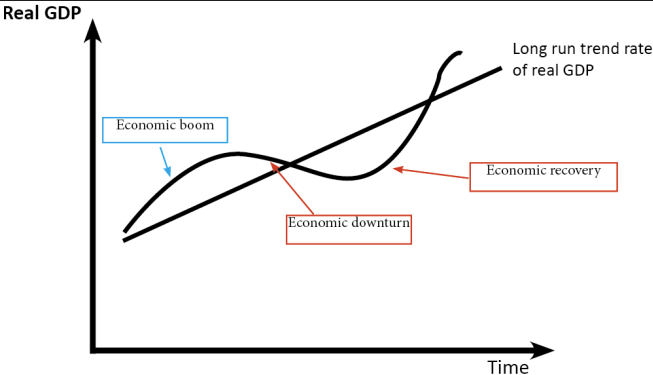
Monthly Indicators to Date Recessions
Real personal consumption expenditures
Non-farm employment
Real after-tax household income
Why does Cyclical Unemployment rise during Recessions?
Decrease in unemployment lags the recovery
Real wages grow more slowly for those employed
Promotions and bonuses are often deferred
New labour market entrants have difficulty finding work
What does Inflation generally do during a Business Cycle?
decreases and at other times as well
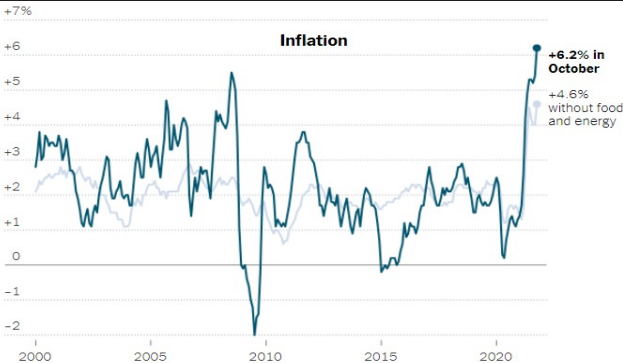
Potential/Full-Employment Output (Y*)
The maximum sustainable amount of output that an economy can produce
Use capital and labour at greater than normal rates and exceed Y*
for a period of time
Grows over time
Actual output grows at a variable rate
Reflects growth rate of Y*
Variable rates of technical innovation, capital formation, weather conditions, etc.
Actual output does not always equal potential output
Output Gaps
The difference between the economy’s actual output and its potential output, relative to potential output, at a point in time
Policy makers consider stabilization policies when there are output gaps
Output Gap in Percent
Y – Y* Y*
Recessionary Gap
a negative output gap; Y* > Y
Capital and labour resources are not fully utilized
Output and employment are below normal levels
mean output and employment are less than their sustainable level
Expansionary Gap
a positive output gap; Y* < Y
Higher output and employment than normal
Demand for goods exceeds the capacity to produce them and prices rise
High inflation reduces economic efficiency
lead to inflation
Natural Rate of Unemployment, u*
the sum of frictional and structural unemployment
when cyclical unemployment is 0
occurs when Y is at Y*
Frictional Unemployment
Short-term unemployment related to matching of workers and jobs
Structural Unemployment
Long-term chronic unemployment in normal conditions – perhaps skills are outdated
Cyclical Unemployment
The difference between total unemployment, u, and u*
Recessionary gaps have u > u*
Expansionary gaps have u < u*
Okun’s Law
Relates cyclical unemployment changes to changes in the output gap
One percentage point increase in cyclical unemployment means a 2 percent widening of a negative output gap, measured in relation to potential output
Why does the Economy adjust slowly to changes in Aggregate Demand?
because of sticky wages and prices, due to:
long-term contracts
menu costs
coordination problems
morale effects of wage cuts
Why don’t Markets instantly correct Output Gaps?
time needed to reach equilibrium
firms change prices infrequently due to menu costs
frequent changes confuse customers
firms produce based on current demand, not equilibrium
In the long run, what determines the level of output in the Economy?
the economy’s productive capacity, not spending
Self-Correcting Mechanisms
Firms eventually adjust to output gaps
If spending is less than potential output, firms will slow the increase of their prices
If spending is more than potential output, firms increase prices
Potential inflationary pressures
Eventually in the long-run, prices reach equilibrium and eliminate output gaps
Production is at potential output levels
Output is determined by productive capacity (capital and labour)
Spending influences only price levels and inflation (monetarism point of view)
Mortgage-Backed Security
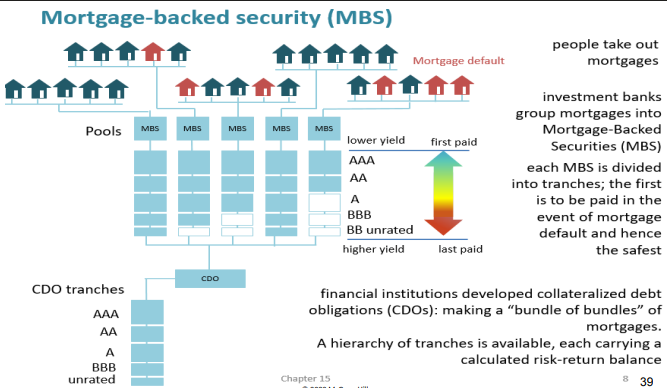
Credit Default Swap
a security that is effectively an insurance policy against defaults related to MBS and CDOS

Subprime Mortgage Securitisation
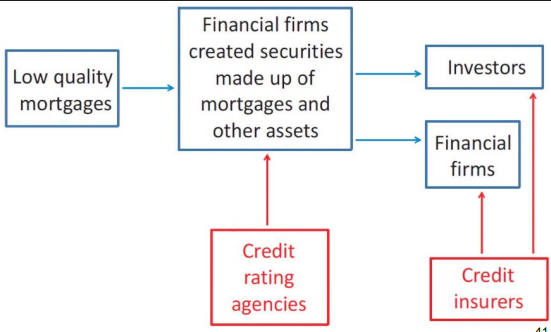
Financial Panic
occurs when providers of short-term credit (depositors in a bank) suddenly lose confidence in the ability of the borrower (the bank) to repay; providers of short-term credit then quickly redraw their funds
Viscous Recessionary Spiral
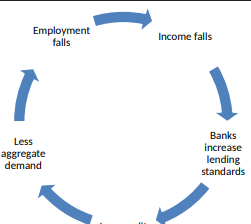
Criticism of Financial Regulations
bills create significant costs for financial firms, slowing down business and job creation
legislation is too complex
legislation has been “watered down” by lobbying efforts
How to Redirect Finance to the Goal of Increasing Overall Benefits to Society
limit speculative activities of banks
ban overly complex products or risky products
ask investors to pay a modest tax on financial transactions (Tobin tax)